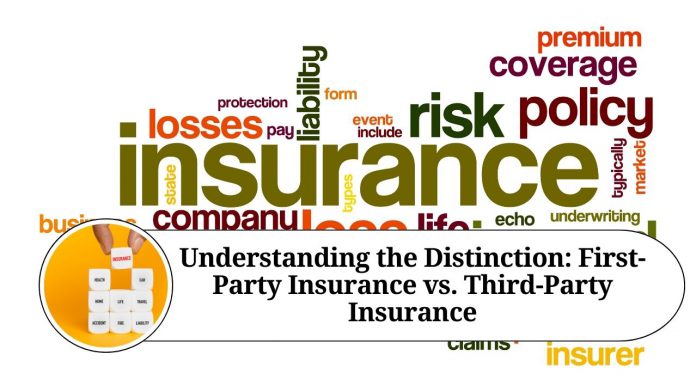Introduction
Insurance plays a crucial role in our lives, protecting us from unforeseen events and providing financial security. However, navigating through the world of insurance can be overwhelming, especially when faced with different terms and policies. One common differentiation is between first-party insurance and third-party insurance. In this blog, we will explore the differences between these two types of insurance, helping you understand their unique characteristics and implications.
First-Party Insurance
Protecting Your Assets First-party insurance, also known as “property insurance” or “first-party coverage,” refers to a type of insurance policy that covers losses and damages directly suffered by the policyholder or their property. When you purchase first-party insurance, you are essentially protecting your own assets from potential risks.
Coverage
First-party insurance policies provide coverage for various types of assets, such as your home, vehicle, business, or personal belongings. These policies typically include protections against damage caused by natural disasters, accidents, theft, fire, vandalism, and other covered perils. If an insured event occurs, the insurance company compensates the policyholder for the loss or damage incurred, up to the limits specified in the policy.
Benefits
One significant benefit of first-party insurance is the peace of mind it brings. By insuring your assets, you ensure that you will not face significant financial hardships in the event of a covered loss or damage. First-party insurance policies can provide compensation for repairing or replacing the insured property, allowing you to recover and move forward without shouldering the entire financial burden.
Examples
Examples of first-party insurance policies include homeowner’s insurance, auto insurance, renter’s insurance, and business property insurance. These policies protect the policyholder’s property and personal belongings against potential risks, providing a safety net in case of unexpected events.
Third-Party Insurance
Protection Against Liability On the other hand, third-party insurance, also known as “liability insurance” or “third-party coverage,” is designed to protect you from claims made by others against you. Unlike first-party insurance, which covers your own losses, third-party insurance focuses on your legal obligations and potential liability towards others.
Coverage
Third-party insurance policies primarily cover liabilities arising from accidents or incidents where you are found legally responsible for causing harm or damage to someone else’s property, health, or well-being. This type of insurance is commonly associated with liability coverage in auto insurance or general liability insurance for businesses. In these cases, the insurance company will compensate the injured party or cover the legal expenses associated with defending against a claim.
Benefits
The main benefit of third-party insurance is the protection it offers against legal claims and financial obligations resulting from your actions. Whether you accidentally damage someone’s property or cause an injury, having a third-party insurance policy in place can safeguard your finances and provide compensation to the affected parties.
Examples
Auto liability insurance, professional liability insurance, and public liability insurance are examples of third-party insurance. These policies protect policyholders from claims made by third parties, ensuring that they are not personally liable for the resulting damages or legal costs.
Conclusion
In summary, the distinction between first-party insurance and third-party insurance lies in the coverage they provide and the parties involved. First-party insurance protects the policyholder’s assets, compensating them for losses or damages they personally incur. On the other hand, third-party insurance shields policyholders from claims made by others, covering liabilities arising from their actions.
Understanding the differences between these two types of insurance is crucial when selecting appropriate coverage for your needs. Whether you’re safeguarding your property or protecting yourself from potential liability, insurance provides an essential safety net in an unpredictable world.
Read More Useful Content:
- Top Benefits of E-Invoicing Software For Your Business
- Best e-Invoicing Software to Simplify Your GST e-Invoicing
- E-invoicing – Guide On E-Invoicing System In India
- How to Generate Electronic Invoicing (e-Invoicing) in Marg ERP Software
- GST E-invoice
Frequently Asked Questions (FAQs)
Q1: What is first-party insurance?
A1: First-party insurance, also known as property insurance or first-party coverage, is a type of insurance that covers losses and damages directly suffered by the policyholder or their property. It protects your own assets against potential risks.
Q2: What is third-party insurance?
A2: Third-party insurance, also referred to as liability insurance or third-party coverage, is designed to protect you from claims made by others against you. It focuses on your legal obligations and potential liability towards others.
Q3: What does first-party insurance cover?
A3: First-party insurance policies provide coverage for various assets such as your home, vehicle, business, or personal belongings. They typically protect against damage caused by natural disasters, accidents, theft, fire, vandalism, and other covered perils.
Q4: What does third-party insurance cover?
A4: Third-party insurance primarily covers liabilities arising from accidents or incidents where you are found legally responsible for causing harm or damage to someone else’s property, health, or well-being. It provides protection against legal claims and financial obligations resulting from your actions.
Q5: How does first-party insurance benefit policyholders?
A5: First-party insurance offers peace of mind by ensuring that you will not face significant financial hardships in the event of a covered loss or damage. It can provide compensation for repairing or replacing your insured property, allowing you to recover without shouldering the entire financial burden.
Q6: How does third-party insurance benefit policyholders?
A6: Third-party insurance protects policyholders from claims made by third parties. It helps cover the legal expenses associated with defending against a claim or compensates the injured party for damages caused by your actions, thus safeguarding your finances.
Q7: What are examples of first-party insurance?
A7: Examples of first-party insurance include homeowner’s insurance, auto insurance, renter’s insurance, and business property insurance. These policies protect the policyholder’s property and personal belongings against potential risks.
Q8: What are examples of third-party insurance?
A8: Auto liability insurance, professional liability insurance, and public liability insurance are examples of third-party insurance. These policies protect policyholders from claims made by others, ensuring that they are not personally liable for the resulting damages or legal costs.
Q9: Can I have both first-party and third-party insurance?
A9: Yes, it is common for individuals and businesses to have both first-party and third-party insurance. They serve different purposes and provide complementary coverage to address various risks and liabilities.
Q10: How do I determine which insurance type is right for me?
A10: To determine the appropriate insurance type, consider your specific needs and risks. If you want to protect your assets, such as your property or personal belongings, first-party insurance is essential. If you want protection against potential liabilities and claims made by others, third-party insurance is necessary. Consulting with an insurance professional can help you assess your needs and find the most suitable coverage.




















